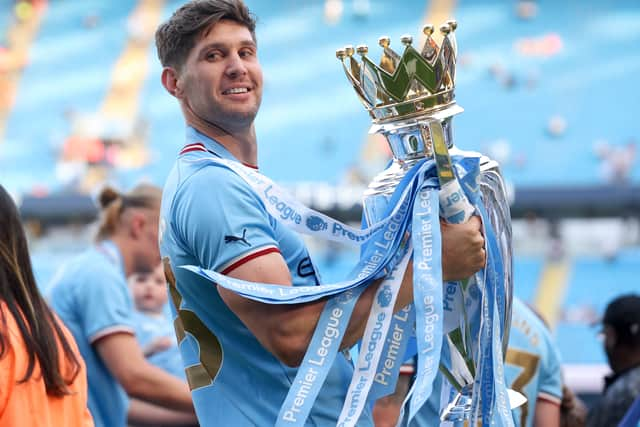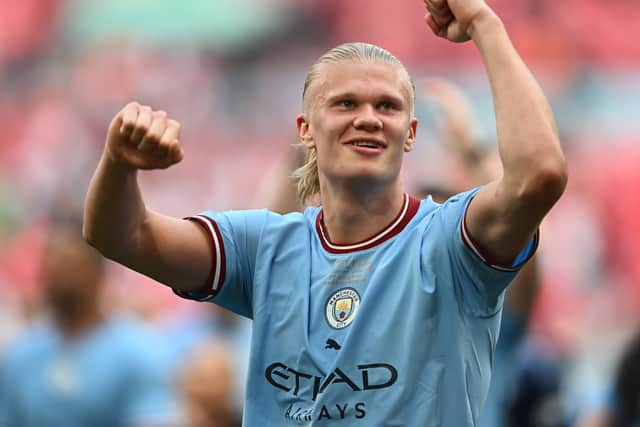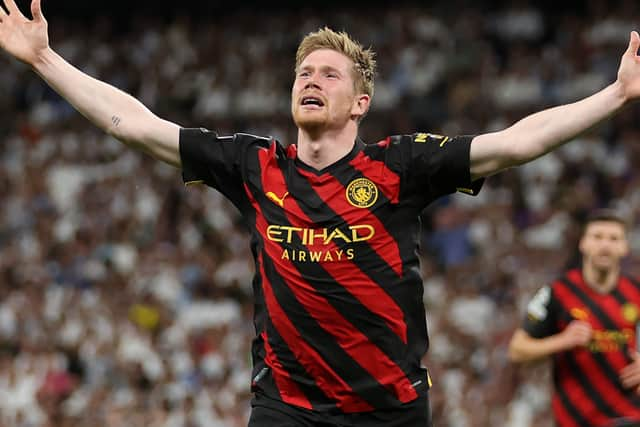This is exactly how Man City can beat Inter and become European champions at last
and live on Freeview channel 276
We all know who the favourites for this year’s Champions League are – right? Manchester City have the players, the form, and the head coach. On paper, they should win and complete a historic treble. There’s no reasonable doubt about that – but this is the Champions League final, the biggest game in club football, and paper isn’t worth a damn in a match like this.
And if you think Inter Milan don’t stand a chance, think again. Man for man, they don’t possess the same quality as their opponents, but tactically, they’re pretty well set up against a City side who have perfected a tactical system designed to shut down the lone striker 4-3-3 variations that dominate the Premier League and much of the modern game. It worked to perfection against Real Madrid in the semi-finals, and the same strategy was used to incredibly good effect down the home stretch of the domestic season.
Advertisement
Hide AdAdvertisement
Hide AdBut the same system that worked so well against Real – a 4-3-3 which morphs into a 3-2-4-1, with John Stones typically acting as the bridge between the two formations – may not be so well designed for Inter, who play a 3-5-2 under manager Simone Inzaghi.


Since the semi-finals, City have played one game against a 3-5-2 system – and it was the only match they lost in that time, a 1-0 defeat to Brentford. Granted, it was after the Premier League had been won, and granted that several younger players like Rico Lewis and Cole Palmer were given minutes they wouldn’t have got had there been more riding on the outcome. Reading too much into that one game might be dangerous – but there are warning signs there.
Warning signs for Pep Guardiola
The way City set up to choke counter-attacks in the middle of the park, with John Stones stepping up to bottleneck the midfield, was far less effective against a team with two men up top. Against Real, that set-up left a one-on-one situation at the back, a two against two in midfield (Rodri and Stones against Luke Modrić and Toni Kroos) and two-on-ones in City’s favour in the wide areas, with the wingers tracking back to help cover the wider defenders, Nathan Aké and Kyle Walker. Against Brentford, who had two men in behind the defensive midfielders and pushed their wing-backs and wider midfielders up the flanks to create overloads, it came across some problems.
If Rúben Dias, playing the centre-half role, has two men to deal with, he could easily get drawn one way and forced to leave space for the other. If one of the wider defenders comes across to plug that gap, that leaves further space on the flanks for the onrushing full-backs and Inter’s two mezzalas, Hakan Çalhanoğlu and Nicolò Barella to double-up and cause havoc. If City go with the same system that has suited them so well, then a team like Inter could find themselves with plenty of chances to get balls into the box for their dual strikers – likely to be World Cup champion Lautaro Martínez and either Romelu Lukaku or former City player Edin Džeko, players who can feast on a high volume of crosses.


Advertisement
Hide AdAdvertisement
Hide AdAt the other end of the field as well, playing against three at the back is a different kettle of fish. Against four-man defensive set-ups, Erling Haaland was able to constantly pose a major question – mark him with one man, and you risk him making enough room to get his shots away, which has usually led to a whole bunch of goals. Double-up and you probably deal with Haaland – but leave space and opportunity for the onrushing midfielders.
If Inter’s defence is well drilled, then they can afford to double-up and still have a floating defender to cover late runs towards the box or behind the line – at least so long as the wing-backs, likely Dutch international Denzel Dumfries and Federico Dimarco, can track back quickly enough to do their job against the wide midfielders.
One thing that works in City’s favour against Inter compared to Brentford is that nature of the strikers Inter play. Against City, Brentford used Bryan Mbeumo and Yoane Wissa, both highly athletic players who were tasked with tracking back out of possession and choking up the middle of the park. Players like Džeko, Lukaku and Martínez, for all their qualities, are not typically as comfortable or as willing to track back and seal up the middle of the park. Against Brentford, City dominated possession (as they so often do) but were frequently forced to play the ball wide rather than being able to create overlaps and two-on-ones through the middle, where they’re more dangerous. City are simply not as threatening when crossing than they are when creating space with quick exchanges in narrower areas.
Another big caveat when it comes to drawing lessons from the Brentford game – Haaland was rested. Had he been playing, he would have increased the threat level from crosses into the box in a way that Julián Álvarez doesn’t do as well. If Inter can find ways to force City narrow, there will still be plenty of danger involved.
What City can do to change the game
Advertisement
Hide AdAdvertisement
Hide AdSo, what should Pep Guardiola do to make sure that City win on Saturday? Keep things the same and he risks giving Inter more chances to score than he would like. Change things up – and get it wrong – and he will stand accused of more of that famous “overthinking”.
The key is not to make a dramatic shift in the way that they play, or to entirely switch up formation. The key is to win the battle in the wide areas at all times – and here they have their single biggest edge, playing two men down each flank where Inter rely on just one.
Out of possession, the wingers will need to track back hard and cover the wing-backs like their lives depend on it – if Inter can generate wide overloads, there will be a huge problem to handle. In possession, and especially on the counter, there could be wide spaces available on the wings to exploit, and City have to be on them quickly. Whoever plays out wide will have to be ready to run themselves into the ground for the cause. Luckily, that’s rarely a problem for City players.
The way the defence line up out of possession will be incredibly interesting. Logic dictates that the “obvious” way to play would be as a classic back four, with the two strikers man-marked, the near-side full-back shutting down overlaps, and the fourth man ready to deal with late runs into the area. But that would take one man away from the midfield and potentially leave more room for Barella and Çalhanoğlu to operate, which would be distinctly unideal, especially given that both are dangerous with long-range shots.
Advertisement
Hide AdAdvertisement
Hide AdOne way to handle that is that instead of tracking the wing-back, the wide midfielder on the far side of an attack can drop into central midfield to provide the extra man Guardiola wants. That would potentially leave the wing-back in the clear for a cross-field pass, but hopefully the spare man in defence can cover those. A diagonal to the wing-back played in behind could be hugely dangerous, and that would be the big risk of leaving them with more space. There’s no way City can line up which doesn’t leave Inter something to play with – they’re too good for that – but you can make sure that they need to play longer, lower-percentage balls to get into their most dangerous areas.


The midfield battle will also be fascinating. Inter’s midfield three – Marcelo Brozović as the holding player and two midfielders looking to make plays from the half-spaces between defence and midfield, and wing and centre – may be well designed to provide an attacking threat against City’s usual set-up, but leaves some big opportunities in attack. With the forwards unlikely to track back into midfield substantively, there will be chances to double up on Brozović and put the Croatian under huge pressure to avoid exposing the back line.
It’s possible that Inzaghi shows a bit more deference to the quality of City’s midfield – and especially the extremely real threat posed by Kevin de Bruyne – and opts to play Roberto Gagliardini in his midfield three, a box-to-box midfielder who offers much more defensively than either of his usual attacking midfield players. Gagliardini has been out of favour for most of the season but started a couple of matches in the run-in – perhaps just part of rest and rotation, but also perhaps a chance for Inzaghi to take a look at his form and conditioning ahead of a game where a player of his style might be necessary.
If Inter do opt for a more conservative midfield set-up, it could help to reduce space for De Bruyne and the rest of the City midfield – but it would also make life a lot easier in defence, putting less pressure on the centre of the pitch and likely creating fewer coverage requirements. With such a technically superb side, so adept at hogging possession for long periods, Guardiola will not be sad to see his opponents line up in a way that reduces their counter-attacking threat somewhat.
Advertisement
Hide AdAdvertisement
Hide AdThe blunt fact is this – City are better than Inter. Inter’s midfield has enough quality to go toe-to-toe with City in some ways, but there is no area of the field where the Italian side have an advantage in terms of personnel. But if they play to their strengths tactically – and if City fail to adequately cover their opponents – then they have a very real chance of getting a goal or two and giving themselves the opportunity to pull off a stunning victory for their fourth European title.
We want your feedback on 3 Added Minutes - details here
City will probably have most of the ball, and will have plenty of chances to put pressure on Inter – and with the abundant quality that they have, they could well simply rout Inter by virtue of sheer class. But if Inter can counter-attack well, there will be opportunities, especially if Guardiola opts to stay put tactically and stand by the system which has served him so well for the last few months. Just this once, it might be a pretty good idea if Guardiola does start thinking a bit harder than City would be comfortable with…
Comment Guidelines
National World encourages reader discussion on our stories. User feedback, insights and back-and-forth exchanges add a rich layer of context to reporting. Please review our Community Guidelines before commenting.
